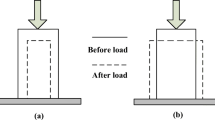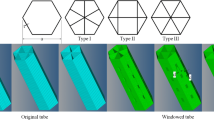Abstract
Door system plays a very important role in the domain of automobile passive safety. In order to improve its side crashworthiness, some affiliated impact components are assembled. Conventional impact parts can make the door system possess enough stiffness and strength so as to ensure the integrity of car body when side collision occurs. But for occupant protection, the excessive rigidity may increase the risk of occupant injury. To address this problem, this work first introduces a kind of negative Poisson’s ratio (NPR) structure, and proposes a novel door system which is composed of NPR energy-absorbing block, NPR impact beam, inner panel, outer panel, and reinforcing plate. Next, parameter sensitivity analysis for each performance index is conducted to determine the corresponding variables when constructing the approximate model. Then, aiming at the disadvantages of the Technology for Order Preference by Similarity to Ideal Solution (TOPSIS) and the Mean Square Deviation Method (MSDM) in processing performance index data, a novel integrated weighting method is used to determine the weighting coefficient of each performance index. Finally, considering side structural crashworthiness, occupant protection, and lightweight, the hierarchical optimization for the novel door system is conducted to further enhance its overall performance. The result demonstrates that compared with the conventional door, the optimal door can improve the performance of occupant protection and ensure the side crashworthiness more effectively.



















Similar content being viewed by others
References
Babaee S, Shim J, Weaver JC et al (2013) 3D soft metamaterials with negative Poisson’s ratio. Adv Mater 25:5044–5049
Buchwalder M, Bühlmann H, Merz M, Wüthrich MV (2006) The mean square error of prediction in the chain ladder reserving method (Mack and Murphy revisited). ASTIN Bull 36:521–542
Fang H, Solanki K, Horstemeyer MF (2005) Numerical simulations of multiple vehicle crashes and multidisciplinary crashworthiness optimization. Int J Crashworthiness 10:161–172
Ghadianlou A, Abdullah SB (2013) Crashworthiness design of vehicle side door beams under low-speed pole side impacts. Thin-Walled Struct 67:25–33
Gibson LJ, Ashby MF (1997) Cellular solids: structure and properties, 2d ed.
Gierczycka D, Cronin DS (2017) Occupant thorax response variations due to arm position and restraint systems in side impact crash scenarios. Accid Anal Prev 106:173–180
Javid F, Smith-Roberge E, Innes MC et al (2015) Dimpled elastic sheets: a new class of non-porous negative Poisson’s ratio materials. Sci Rep:5
Jiaqiang E, Han D, Qiu A et al (2018) Orthogonal experimental design of liquid-cooling structure on the cooling effect of a liquid-cooled battery thermal management system. Appl Therm Eng 132:508–520
Ju J, Summers JD (2011) Compliant hexagonal periodic lattice structures having both high shear strength and high shear strain. Mater Des 32:512–524
Kelley ME, Talton JW, Weaver AA et al (2019) Associations between upper extremity injury patterns in side impact motor vehicle collisions with occupant and crash characteristics. Accid Anal Prev 122:1–7
Kodiyalam S, Yang RJ, Gu L, Tho CH (2004) Multidisciplinary design optimization of a vehicle system in a scalable, high performance computing environment. Struct Multidiscip Optim 26:256–263
Kumaresan S, Sances A, Carlin F et al (2006) Biomechanics of side impact injuries: evaluation of seat belt restraint system, occupant kinematics and injury potential. Annual International Conference of the IEEE Engineering in Medicine and Biology – Proceedings, In, pp 87–90
Lakes R (1987). Foam structures with a negative poisson’s ratio. Science (80- ) 235:1038–40
Lilehkoohi AH, Faieza AA, Sahari BB, Nuraini AA (2013) Effect of material on crashworthiness for side doors and B pillar subjected to euro NCAP side impact crash test. Adv Sci Lett 19:359–362
Lim TS, Lee DG (2002) Mechanically fastened composite side-door impact beams for passenger cars designed for shear-out failure modes. Compos Struct 56:211–221
Mohotti D, Ali M, Ngo T et al (2013) Out-of-plane impact resistance of aluminium plates subjected to low velocity impacts. Mater Des 50:413–426
Mohsenizadeh S, Alipour R, Nejad AF et al (2015) Experimental investigation on energy absorption of auxetic foam-filled thin-walled square tubes under quasi-static loading. Procedia Manuf 2:331–336
Ohtaki H, Hu G, Nagasaka Y, Kotosaka S (2004) Analysis of negative Poisson’s ratios of re-entrant honeycombs. JSME Int J Ser A Solid Mech Mater Eng 47:113–121
Prawoto Y (2012) Seeing auxetic materials from the mechanics point of view: a structural review on the negative Poisson’s ratio. Comput Mater Sci 58:140–153
Shen HD, Amp ZD (2009) A study on car side structure design aimed at occupant protection in side impact. Auto Eng 31(8):765–768
Trempel RE, Zuby DS, Edwards MA (2016) IIHS head restraint ratings and insurance injury claim rates. Traffic Inj Prev 17:590–596
X.T. Wang, X.W. Li, L. Ma (2016) Interlocking assembled 3D auxetic cellular structures, Mater. Des 99: 467–476
Wang Y, Zhao W, Zhou G et al (2018a) Optimization of an auxetic jounce bumper based on Gaussian process metamodel and series hybrid GA-SQP algorithm. Struct Multidiscip Optim 57:2515–2525
Wang CY, Li Y, Zhao WZ et al (2018b) Structure design and multi-objective optimization of a novel crash box based on biomimetic structure. Int J Mech Sci 138–139:489–501
**ong F, Wang D, Zhang S et al (2018) Lightweight optimization of the side structure of automobile body using combined grey relational and principal component analysis. Struct Multidiscip Optim 57:441–461
Xu F, Sun G, Li G, Li Q (2013) Crashworthiness design of multi-component tailor-welded blank (TWB) structures. Struct Multidiscip Optim 48:653–667
Youn BD, Choi KK, Yang RJ, Gu L (2004) Reliability-based design optimization for crashworthiness of vehicle side impact. Struct Multidiscip Optim 26:272–283
Zhang B, Yang J, Zhong Z (2010) Optimization of vehicle side interior panels for occupant safety in side impact. Int J Crashworthiness 15:617–623
Zhou G, Ma ZD, Gu J et al (2016) Design optimization of a NPR structure based on HAM optimization method. Struct Multidiscip Optim 53:635–643
Funding
The authors received the support of the Natural Science Foundation of Jiangsu Province (Grant BK20180482), and the Fundamental Research Funds for Postgraduate Research & Practice Innovation Program of Jiangsu Province (Grant KYCX19_0158).
Author information
Authors and Affiliations
Corresponding author
Ethics declarations
Conflict of interest
The authors declare that they have no conflict of interest.
Replication of results
All the data presented in this study are generated using CATIA, HYPERMESH, LS-DYNA and ISIGHT. The corresponding FE models can be obtained from the official website: http://www.lstc.com/download. The orthogonal experimental data are listed in Table 2, and the weighting coefficients of IWM and the mathematical models are described in Sections 4.2 and 5.2, respectively. Moreover, the other non-confidential data relevant to the present study are available upon request.
Additional information
Responsible Editor: Erdem Acar
Publisher's note
Springer Nature remains neutral with regard to jurisdictional claims in published maps and institutional affiliations.
Rights and permissions
About this article
Cite this article
Wang, W., Dai, S., Lu, G. et al. Hierarchical optimization of a novel vehicle door system under side impact based on integrated weighting method. Struct Multidisc Optim 63, 2969–2988 (2021). https://doi.org/10.1007/s00158-020-02838-3
Received:
Revised:
Accepted:
Published:
Issue Date:
DOI: https://doi.org/10.1007/s00158-020-02838-3




